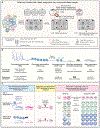The loud minority: Transcriptionally active HIV-1-infected cells survive, proliferate, and persist
- PMID: 35063069
- PMCID: PMC9195179
- DOI: 10.1016/j.cell.2021.12.038
The loud minority: Transcriptionally active HIV-1-infected cells survive, proliferate, and persist
Abstract
The shock-and-kill strategy reactivates HIV-1 latent reservoir for immune clearance. Einkauf et al. found that some HIV-1-infected cells that persist and proliferate have transcriptionally active HIV-1 in permissive chromatin. Silent proviruses in repressive chromatin resist reactivation. Understanding HIV-1-chromatin interactions and how transcriptionally active HIV-1-infected cells survive is a pressing need.
Copyright © 2021 Elsevier Inc. All rights reserved.
Figures

Comment on
-
Parallel analysis of transcription, integration, and sequence of single HIV-1 proviruses.Cell. 2022 Jan 20;185(2):266-282.e15. doi: 10.1016/j.cell.2021.12.011. Epub 2022 Jan 12. Cell. 2022. PMID: 35026153 Free PMC article.
References
-
- Chen HC, Martinez JP, Zorita E, Meyerhans A, and Filion GJ (2017). Position effects influence HIV latency reversal. Nat. Struct. Mol. Biol 24, 47–54. - PubMed
Publication types
MeSH terms
Substances
Grants and funding
- UM1 AI126620/AI/NIAID NIH HHS/United States
- R01 DA051906/DA/NIDA NIH HHS/United States
- UM1 AI164565/AI/NIAID NIH HHS/United States
- UM1 DA051410/DA/NIDA NIH HHS/United States
- UM1 AI164570/AI/NIAID NIH HHS/United States
- R01 AI145164/AI/NIAID NIH HHS/United States
- R33 DA047037/DA/NIDA NIH HHS/United States
- U01 DA053628/DA/NIDA NIH HHS/United States
- P50 AI150464/AI/NIAID NIH HHS/United States
- R61 DA047037/DA/NIDA NIH HHS/United States
- T32 AI055403/AI/NIAID NIH HHS/United States
- R01 AI141009/AI/NIAID NIH HHS/United States
- R37 AI147868/AI/NIAID NIH HHS/United States
LinkOut - more resources
Full Text Sources
Medical

